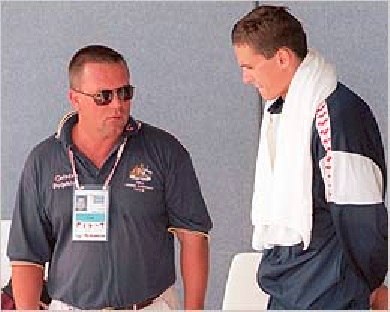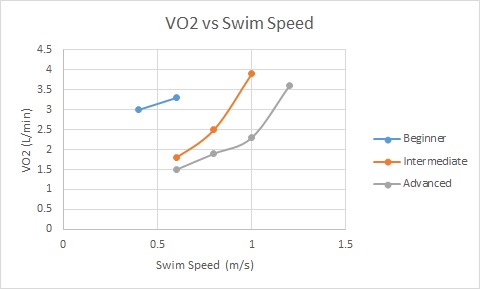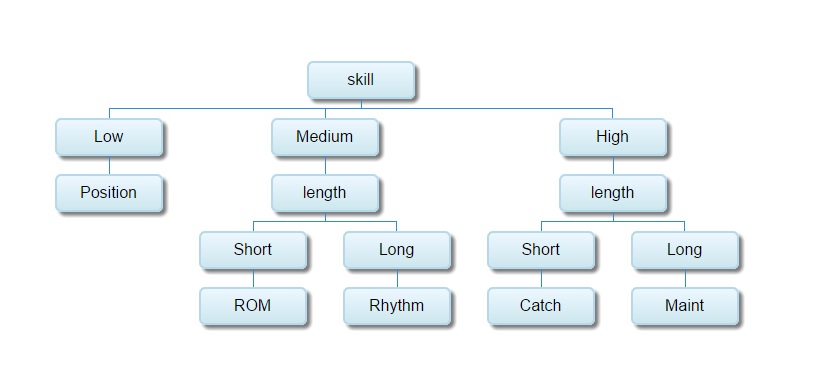Addressing your swim limiter part 3:
A cure for what ails you.
Alan Couzens, MS (Sports Science)
May 23rd, 2016

With the influx of athletes coming out of their winter hibernation to re-familiarize themselves with the aquatic medium, swimming is fresh on the mind. Actually, more specifically, the difference in paces that I see between former swimmers who haven't touched the water in several months (& have touched several bags of donuts over said months) versus those type A 'worker bees' who've been doggedly accumulating laps over the winter in an effort to improve their swimming is most at the forefront.
Triathletes, on the whole, just don't get it...
Every day I’m approached by a triathlete with a swim weakness who wants to throw more volume at the problem. Well, if elite swimmers are swimming 80K a week and I’m only swimming 15 is it any wonder I’m ‘slow’? This is a fact, but it’s also a fact that said elite swimmer could take 20 years out of the pool, put on a momentous beer gut and still kick your butt over any distance(!) When it comes to swimming fast, fitness is only one part of the equation.
Put more bluntly: You simply can't 'out-work' a superior stroke. This is true at all levels...
The shorter guy in the pic above is legendary swim coach, Gennadi Touretski. The tall guy is legendary swimmer, Alex Popov. The short time that I spent at the Australian Institute of Sport observing and learning from Gennadi had a profound impact on my approach to coaching in a number of areas, but one of the most significant is the importance of constant and never ending attention to the development of technique
At the time that I was observing Gennadi's approach with Alex, Gennadi was the head swim coach of the Australian National Program and Alex was the fastest swimmer in the world - a 48 second 100 meter freestyle phenom who, despite moving at lightning speed always looked in perfect control of coordinating the movements of his body (you can see Alex in action in the title video from Part 1 here). This ability to hold perfect form under all conditions was not coincidental. It was the result of hour upon hour of focused, deliberate, practice.
Despite having, arguably, the best swimmer in the world in his pool, Gennadi's focus 'on deck' looked a lot more like what you might see from a coach doing a one-on-one 'remedial' technique session with one of his young squad members whose stroke might be 'in need of some work'! Eyes on. Hands on. All the time. But this wasn't a once in a while technique 'polish up', it was a day-in, day-out demand for technical perfection
When Gennadi deemed that Alex's stroke was no longer technically perfect, the session was ended. No gritting through tough sets with sub-optimal technique. No 'thrashing' through the water at 'red line effort'. Technical perfection was demanded. Every rep. Every lap. Every stroke.
This attitude is very much in contrast with the typical AG triathlete's approach of a mix of 99% jump in a masters group & swim a lane up from your ability level coupled with a session or 2 per year (perhaps) of one on one technique 'check ups' with a coach. For Alex, skill training and conditioning were one and the same. Both attributes were given equal (obsessive) attention & both were developed concurrently. If a continued daily obsession with technique is good enough for a guy already swimming 48s for a 100...
Unfortunately, this economy focus is all too uncommon in the swimming world as a whole &, even more so in the Type-A 'outwork your rivals' world of triathlon. While we sing the praises of skill in cycling and running – the ‘souplesse’ of a seasoned cyclists stroke, the grace of Daniel Komen as he runs, the reality is that there is a fairly widespread range of economy at the elite level and some folks with sub-optimal economy are able to gut it out and out-work (or out-diet) their peers. However, in swimming, with the nature of the medium that we’re working with, this approach is much tougher to pull off. In order to swim at a truly fast pace you *need* high levels of economy....
Without a rock solid foundation of technique, it's a matter of time before you find yourself banging your head against a proverbial volume wall - i.e. no matter how much more work you do, you don't go any faster!
To illustrate why this is the case…

Above you’ll see 3 different economy curves from a study by Holmer (1974) for a 'beginner', 'intermediate' & 'advanced' level swimmer. You can see that the faster a swimmer goes, the energy output goes up exponentially, i.e. the more they are ‘penalized’ for poor economy. At a certain point, the intermediate's curve goes ballistic at a much faster rate than the advanced swimmer. At 1m/s (1:40/100m pace), the intermediate swimmer is at a (fitness challenging) VO2 uptake of 4L/min, while the advanced swimmer is at a very manageable (even for Johnny Bag-o-donuts) uptake of 2L/min. That's a lot of extra fitness to make up for the economical short fall, even at a mid-pack swim pace! Put another way, the faster you want to go, the more technically proficient you *have* to be in order to keep up with the ever-increasing drag.
So what makes up this economy?
There is a perception that an economical and a ‘beautiful’ stroke are synonymous but, a look back through the years at the different stroke types we see in Olympic finals shows us that this isn’t necessarily the case. Even comparing the 'textbook' stroke of Alex, with the aggressive stroke of Michael Klim (who I talked about in part 2) there are obvious differences in 'aesthetic appeal' despite similar levels of economy.
No, ‘real world’ economy in the pool has less to do with looking pretty and more to do with the presence of 5 key factors…
- Continuity
- Catch mechanics
- Range of motion
- Relaxation/Long body position
- Kick?
The importance of each is briefly outlined below…
Continuity – As the economy curves show, acceleration and deceleration in the stroke is punished by increased drag. A ‘catch up’ stroke that results in time lags between propulsive phases and constant speeding up and slowing down is no way to be economical!
Catch mechanics – ‘Purchase’ on the water occurs at an angle of attack of ~45 degrees. Getting to this angle of attack early in the stroke is not a normal action. It is very unique to swimming and something that must be practiced over and over to be perfected. But, especially for adult swimmers, practice is only half of the equation…
Range of motion – This high upper arm, 45 degree lower arm – abduction with internal rotation position of a good catch is outside of the range of motion of many athletes who haven’t trained their shoulders to accommodate it in their developing years. Therefore catch ‘practice’ for adult-onset swimmers is as much a stretching exercise as a learning exercise.
Relaxation/Body position – Our innate tendency is to avoid submersion, i.e. not drown(!) but a good body position & a good breathing position requires being very comfortable with being semi-submerged, even when in the very vulnerable position of taking a breath(!) Folks have a tendency to fight this and want to be on top of the water. Good distance swimmers swim in (maybe even a little under) the water.
Kick? – While I know a number of relatively fast tri swimmers with poor kick ability, I see significant benefit in improving the kick in 2 areas –
1. If you can’t plantar flex the feet/ankles, you’ll be compromising the streamline of the ‘vessel’ so, even if not kicking, having the ankle flexibility of someone who *can* kick is a positive thing.
2. At high levels of competition, having that extra speed that a good kick can bring is a great weapon to have in terms of bridging to, or getting back on packs.
That’s a lot to tackle!
One of the greatest challenges (& frankly, greatest frustrations) as a coach who works with a lot of remote athletes is not being able to 'eyeball' the athlete on a daily basis. This is particularly the case for the swim. When on deck, I am able to make real time 'on the fly' drill/technique recommendations based on what I'm seeing with the athlete's stroke. However, applying this feedback-prescription loop in a remote setting is far more challenging. Even with advances in technology, I'm not sure I've found a great solution to that issue as yet but I am confident that better solutions will continue to come from better individualization of the 'technique work' prescribed.
In the previous post, I referenced a really useful classification system invented by the guys at Swimsmooth that can help to make sense of it all & help to channel your focus to what really matters for a particular 'type' of swimmer. I’d encourage you to check it out, along with the incredible resource that is their site for much more detail on the concepts I’m about to lay out.
The below shows a simple 'decision tree' that takes the athlete through the steps that I have outlined to make a decision on what the athlete's current technical focus should be: Whether range (ROM/catch), rhythm, or relaxation/body position work. Or, a smaller selection of maintenance drills to hold onto the athlete's current economy if it's already strong.

Athletes are first classified according to skill level (low, medium or high) based on either measured economy or estimated economy from the relationship between their swim speed and their (less economy dependent) bike power. Then, athletes are further classified based on their stroke length/rate relative to their height to further identify the source of their weakness - taking too many strokes & letting their arm 'slip' through the water or, equally problematic, taking too few strokes (having an excessively low rate) by having too much of a glide between strokes. For a real world application of the above concept in an easy to use swim limiter 'calculator' see part 2
A summary of the classification logic is as follows...
If the athlete is not getting a lot of speed for their fitness despite having an apparently long stroke (due to a thunder kick), they may be rhythm, or 'continuity' limited. Another dead giveaway for this type of swimmer is the inability to change pace (i.e. minimal shift from easy-steady-moderate-max paces) – they are 'one speed' swimmers.
If the athlete is not getting a lot of speed for their fitness and they are also taking a lot of strokes per length, they may be range limited, i.e. they are getting a late or minimal catch and, effectively 'spinning their wheels'
If the athlete is moderately skilled but taking less strokes than might be ideal (& having too much of a gap between strokes) they may be 'over-gliding' (per the swim smooth vernacular) & will likely benefit from drills that focus on minimizing the 'time out front' & getting into an immediate catch
If the athlete is moderately skilled but taking more strokes than might be ideal, slowing things down a little to 'polish up' the catch mechanics may be prudent.
The bottom line is that athletes can be skilled or unskilled in very different ways and adopting a generic drill selection may do more harm than good!
So what do we do?
Focus the specific technique work on the specific limiter of that individual athlete…
Below you'll find a 'menu' of technical exercises that I've found useful for each respective limiter
Continuity (Rhythm)
- Tempo trainer swimming ('wetronome')
- Pull/band swimming
- Drills from the hips, i.e. other arm stays at side during one arm drills e.g. 3R/3L/3 Switch.
- Fin swimming with equal number of strokes to regular swimming
- Head up ‘Tarzan’ swimming
- Freestyle with fly kick
- Tethered Swimming - maybe most difficult to incorporate but VERY useful for folks w/continuity issues. Gives immediate feedback on gaps in the stroke as the athlete is pulled back by the band.
Catch mechanics/ROM (Range)
- Side kick drill (& switch drills) holding hand in catch position
- Dryland work – SMR/Stretching + Swim cordz - VERY helpful!
- Snorkel swimming (watch the catch)
- Finger/fulcrum paddles
Relaxation
- Sink drill
- Floating/Sculling (front/back)
- ‘Sneaky breath” breathing practice while standing.
- Streamline for distance/underwater work.
- ‘Pig on a spit’ drill – 10 kicks front, right side, back, left side with arms by side
- Side kick/switch drills – arms forward and by side
The above may be broken down into a sample week for each given limiter as follows - addressing both specific conditioning objectives - aerobic, moderate/threshold, speed/VO2, recovery along with specific technical objectives - relaxation/body position, rhythm/continuity, range/catch mechanics

As you progress through the ‘remedy’ you may find another ‘ailment’ cropping up, e.g. an athlete who has an apparently ‘long’ stroke due to a pause in the stroke may find that after addressing their continuity limiter, that their stroke isn’t truly long at all – it was all an illusion coming from excessive glide in the stroke! And, when we strip out the pause, a new weakness in their catch mechanics is revealed. It’s a process of progressively revealing and addressing weaknesses through the training blocks but doing so in a systematic, focused manner.
Train smart,
AC
TweetDon't miss a post! Sign up for my mailing list to get notified of all new content....
